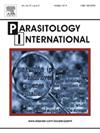评价新型抗疟药N-89对伯氏疟原虫感染小鼠配子体的作用
IF 1.5
4区 医学
Q3 PARASITOLOGY
引用次数: 0
摘要
我们开发了一种1,2,6,7-四氧阿斯皮罗[7.11]壬烷(td N-89)的透皮制剂,用于五岁以下儿童,他们占疟疾死亡的大多数,因为儿科难以多次口服剂量。Td N-89有望作为一种新的抗疟候选药物,在体内靶向利用伯氏疟原虫的滋养体。伯氨喹(PQ)是目前唯一针对间日疟原虫和卵形疟原虫的肝期寄生虫的药物。当PQ联合用于靶配子体时,需要谨慎防止PQ耐药。为了研究td N-89对配子细胞的影响,我们通过测量td N-89处理后配子细胞相关基因的表达水平来评估其杀死配子细胞的活性。以伯氏假体表面蛋白(Pbs21)和生殖细胞特异性1(GCS)作为雌雄配子体的标记物。ED90剂量下,Pbs21和GCS的表达水平增加。在以td青蒿素为对照的小鼠中,Pbs21和GCS的表达水平高于td N-89组,表明td青蒿素比td N-89具有更高的抗无性寄生虫活性。然而,用青蒿素治疗的所有小鼠均出现复发并死亡。相比之下,接受td N-89治疗的小鼠中,尽管有1.7%的寄生虫病,但仍有33.3%的小鼠获得了治愈。我们首次报道了配子体相关基因表达在td N-89组中逐渐改变,并且可以长时间检测到。综上所述,我们的结果表明td N-89的目标主要是滋养体而不是配子体。本文章由计算机程序翻译,如有差异,请以英文原文为准。
Evaluating the effect of new antimalarial N-89 for gametocytes in P. berghei-infected mice
We have developed a transdermal formulation of 1,2,6,7-tetraoxaspiro [7.11] nonadecane (td N-89) for children under the age of five, who account for the majority of malaria deaths, as multiple oral doses are difficult to administer to pediatric. Td N-89 shows promise as a new antimalarial candidate for targeting trophozoites using Plasmodium berghei in vivo. Primaquine (PQ) is currently the only drug that targets the liver stage parasites against P. vivax and P. ovale. When PQ is used in combination to target gametocytes, caution is required to prevent PQ resistance. To investigate the effect of td N-89 on gametocytes, we assess the gametocytocidal activity by measuring the expression levels of gametocyte-related genes following td N-89 treatment. The P. berghei ookinete surface protein (Pbs21) and generative cell-specific 1(GCS) were used as markers for female and male gametocytes. Expression levels of Pbs21 and GCS increased during td N-89 at ED90 dose. In mice with td artemisinin as a reference, Pbs21 and GCS expression levels were higher than those in the td N-89 group, suggesting that td artemisinin exhibited higher anti-asexual parasite activity compared to td N-89. However, all mice treated with td artemisinin showed recrudescence and died. In contrast, 33.3 % of mice treated with td N-89 achieved a cure despite 1.7 % parasitemia. We report for the first time that gametocyte-related genes expression progressively changes in the td N-89 group and can be detected for a long period. Taken together, our results suggest that target of td N-89 is mainly trophozoites and not gametocytes.
求助全文
通过发布文献求助,成功后即可免费获取论文全文。
去求助
来源期刊

Parasitology International
医学-寄生虫学
CiteScore
4.00
自引率
10.50%
发文量
140
审稿时长
61 days
期刊介绍:
Parasitology International provides a medium for rapid, carefully reviewed publications in the field of human and animal parasitology. Original papers, rapid communications, and original case reports from all geographical areas and covering all parasitological disciplines, including structure, immunology, cell biology, biochemistry, molecular biology, and systematics, may be submitted. Reviews on recent developments are invited regularly, but suggestions in this respect are welcome. Letters to the Editor commenting on any aspect of the Journal are also welcome.
 求助内容:
求助内容: 应助结果提醒方式:
应助结果提醒方式:


